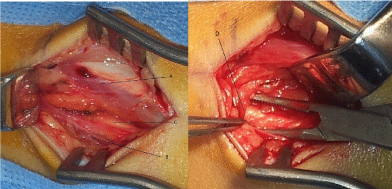Journal of Neurology, Neurological Science and Disorders
Anterior Tarsal Tunnel Syndrome with Presence of Accessory Deep Peroneal Nerve: Case Report
Osman Sinanović1, Sanela Zukić1*, Nermina Pirić1, Harun Brkić2, Mirsad Hodžić2, Renata Hodžić1, Mirza Baručija1
2Department of Neurosurgery, University Clinical Center Tuzla, 75000 Tuzla, Bosnia and Herzegovina
Cite this as
Sinanović O, Zukić S, Pirić N, Brkić H, Hodžić M, et al. (2015) Anterior Tarsal Tunnel Syndrome with Presence of Accessory Deep Peroneal Nerve: Case Report. J Neurol Neurol Sci Disord 1(1): 015-016. DOI: 10.17352/jnnsd.000004Objective: Entrapment neuropathy of the deep peroneal nerve, also recognized as anterior tibial nerve, typically occurs at the anterior ankle and dorsal foot.
Entrapment neuropathy of the deep peroneal nerve, also recognized as anterior tibial nerve, typically occurs at the anterior ankle and dorsal foot. Compression of this nerve, which anatomically is inferior to the extensor retinaculum, is commonly referred to as anterior tarsal tunnel syndrome. This syndrome is rare and remains poorly diagnosed among clinical problems. A 25-year-old woman was referred to our outpatient clinic for a second opinion. She presented with a vague pain over the dorsomedial aspect of the foot which occasionally radiated into the first intertarsal space. Electromyography revealed moderate prolongation of distal latency and presence of accessory deep peroneal nerve (ADPN) with partially innervated extensor digitorum brevis. Our diagnosis was anterior tarsal tunnel syndrome, and surgical decompression of the anterior tarsal tunnel was performed. At the follow up three months later the symptoms where almost completely gone. One year after, there were still no symptoms.
The ADPN is of great clinical and surgical importance. In the presence of ADPN, the lesion of the deep peroneal nerve spare the lateral portion of the EDB, leading to the possibility of an incorrect conclusion, as it was the case with our patient.
Introduction
The anterior tarsal tunnel syndrome (ATTS) is the name for a usually spontaneous compression syndrome of the mixed terminal branch of the deep peroneal nerve (DPN) at the dorsum of the foot under the cruciform portion of the fibrous sheaths (cruciate ligament or extensor retinaculum) [1,2]. The anterior tarsal tunnel (ATT) is formed by the fascia lining the inferior extensor retinaculum and talus as well as the navicular bone. The roof of the tunnel is the inferior extensor retinaculum. The floor is the fascia overlying the talus and navicular bone. Within the tunnel are four tendons, an artery, a vein, and the deep peroneal nerve.
DPN and its branches cross through this fibro-osseous canal by extending deep to the muscle tendons of the extensor hallucis longus and extensor digitorum longus towards the distal direction [3,4]. DPN innervates the peroneus tertius muscle and the dorsiflexors of the ankle and toes, including the tibialis anterior muscle, extensor digitorum longus and extensor hallucis longus, and extensor digitorum brevis (EDB) [5,6].
The syndrome has first been identified by Kopell and Thompson in 1963 [7], and in 1968, Marinachi [8], revealed the etiology and clinical signs of this syndrome more clearly and named it “the anterior tarsal tunnel syndrome” in order to differentiate it from medial tarsal tunnel syndrome. Furthermore, he established the electrodiagnostic technique to assist in the diagnosis. This syndrome occurs more commonly among women [4].
ATTS is characterized by pain and sensory disturbances (numbness, hyperesthesia and paresthesia) over the first interdigital and intermetatarsal space, pain over dorsum of the foot, and a subjectively silent weakness of the extensor digitorum brevis muscles. Patients may also complain of a burning sensation in the distribution of the DPN. The pain may be influenced by particular body positions during rest and ambulation. AATS of the DPN is an often under-diagnosed and poorly recognized clinical entity [5,9].
Case Report
A 25-year-old woman was referred to our out-patient clinic for a second opinion. She complained of a vague pain over the dorsomedial aspect of the foot (Figure 1) which occasionaly radiated into the first interosseal space.
Occasionaly she complained of numbness within this area. Symptoms started nine months ago during the last trimester of her pregnancy. Her symptoms were often aggravated by physical activities especially with activities involving the left leg. She was diagnosed as “atypical left L5/Sl radiculopathy” at another university department. Examination showed no sensory loss and mild atrophy of left EDB.
Electromyography revealed moderate denervation in left EDB. The motor conduction velocity of the left deep peroneal nerve proximal to the ankle was normal, with moderate prolongation of distal latency and presence of accessory deep peroneal nerve (ADPN) with partially innervated EDB (Figure 2). ADPN was also present on the right side. Our diagnosis was anterior tarsal tunnel syndrome, and the patient was treated surgically at our Department of Neurosurgery resulting with reduction of the pain and numbness. Surgical procedure. Surgery was performed via a 2 cm long transversal incision and the deep peroneal nerve was exposed proximally to the extensor retinaculum.
A surgical decompression of the anterior tarsal tunnel was performed (Figure 3), and at the follow-up three months later the symptoms where almost completely gone. One year later, the symptoms were still absent.
Discussion
Entrapment neuropathy of the deep peroneal nerve (DPN), also recognized as anterior tibial nerve, typically occurs at the anterior ankle and dorsal foot. Compression of this nerve, which anatomically is inferior to the extensor retinaculum, is commonly referred to as anterior tarsal tunnel syndrome (ATTS). This syndrome is rare and remains poorly diagnosed among clinical problems [3,10].
The accessory deep peroneal (ADPN) nerve has been regarded as an anomalous nerve derived from the superficial peroneal nerve or its branch and supplies motor innervations for extensor digitorum brevis (EDB) and sensory innervations for the lateral part of the ankle and foot regions. The EDB is usually innervated exclusively by the deep peroneal nerve, a major branch of the the common peroneal nerve, however, in as many as 28% of patients (with same male/female frequency), one or both of the EDB muscles are (partially or exclusively) innervated by the ADPN nerve [11].
When performing neurographic examinations, the presence of ADPN should be suspected if the amplitude and area of a response recorded from EDB is higher after supramaximal stimulation of the peroneal nerve at a proximal rather than at a distal point, or if there is no response of EDB following peroneal nerve stimulation at distal part of the nerve. In such cases it is necessary to stimulate the nerve behind the lateral malleolus [12].
Conclusion
The ADPN is of great clinical and surgical importance. In the presence of ADPN, the lesion of the deep peroneal nerve spare the lateral portion of the EDB, leading to the possibility of an incorrect conclusion, as it was the case with our patient.
- Borges LF, Hallet M, Selkoe DJ, Wlch K (1981) The anterior tunnel syndrome: Report of two cases. J neurosurg 54: 89-92.
- Andresen B, Wertsch J, Stewart W (1992) Anterior tarsal tunnel syndrome. Arch Phys Med Reh 73: 1112-1117.
- Liu Z, Zhou J, Zhao L (1991) Anterior tarsal tunnel syndrome. J Bone Joinnt Surg 73: 470-473.
- Cetinkal A, Topuz K, Kaya S, Colak A, Demircan MN (2011) Anterior tarsal tunnel syndrome secondary to missed talus fracture: a case report. Turkish Neurosurgery 21: 259-263.
- Masakado Y, Kawakami M, Suzuki K, Abe L, Ota T, et al. (2008) Clinical neurophysiology in the dignosis of peroneal nerve palsy. Keio J Med 57: 84-89.
- Sinanovic O, Piric N (2010) Musculus extensor digitorum brevis is clinical and electrophysiological marker for L5/Sl radicular lesions. Med Arh 64: 223-224.
- Kopell HP, Thompson WAL (1963) Peripheral entrapment neuropathies. Baltimore: Williams and Wilkins: 35-37.
- Marinacci AA (1968) Medial and anterior tarsal tunnel syndrome. Electromyography 8: 123-134.
- Miliam PB, Basse PN (2009) Anterior tarsal tunnel syndrome. Ugeskr Laeger 171: 1194.
- DiDomenico LA, Masternick EB (2006) Anterior tarsal tunnel syndrome. Clin Podiatr Med Surg 23: 611-620.
- Kuruvilla A (2004) Accesory deep peroneal nerve. Neurol India 52: 135-135.
- Sinanovic O, Zukic S, Sakic A, Muftic M (2013) The accessory deep peroneal nerve and anterior tarsal tunnel syndrome: case report. Acta Myol 32: 110-112.
Article Alerts
Subscribe to our articles alerts and stay tuned.
 This work is licensed under a Creative Commons Attribution 4.0 International License.
This work is licensed under a Creative Commons Attribution 4.0 International License.




 Save to Mendeley
Save to Mendeley
